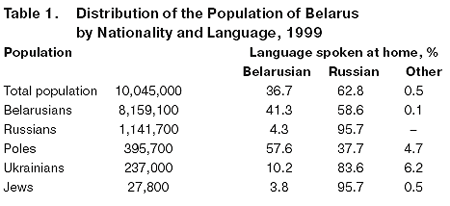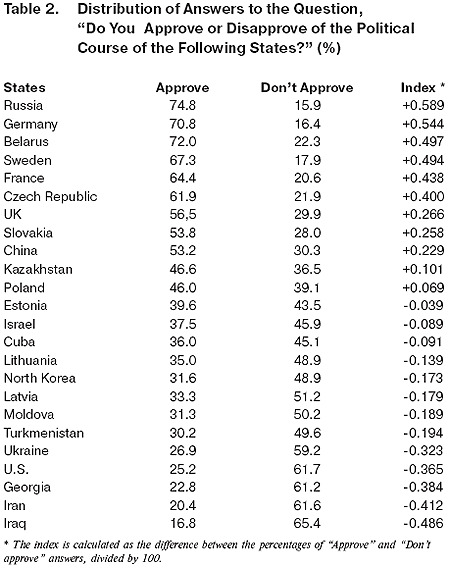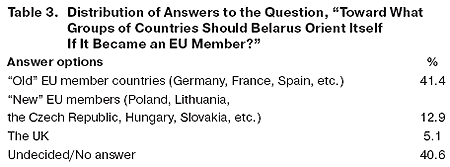Some people are
beginning to ask the questions: What role will Belarus play in the
European Union? Will it end up among the countries that former U.S.
Defense Secretary Donald Rumsfeld dubbed “New Europe,” or will it
become an eastern stronghold for such states as Germany and France?
The very question sounds bizarre since Belarus, which is referred
to as “the last dictatorship of Europe” on both sides of the
Atlantic, has slim chances of becoming a EU member in the
foreseeable future.
Yet the world
today is changing so rapidly that nothing should be taken for
granted. The dramatic turn in relations that occurred between such
close allies as Moscow and Minsk in late 2006 and early 2007, as
well as Alexander Lukashenko’s warming to the West, only shows that
nothing can be ruled out.
EAST OR
WEST?
Many Russian
authors tend to describe the ongoing political struggles in Belarus
in terms of an age-old confrontation between Rus (Old Russia) and
Poland. Numerous studies are devoted to the analysis of “Polish
intrigue” – i.e., Warsaw’s dream about the restoration of
Rzeczpospolita to its former glory. These writers demonstrate a
good knowledge of history. Indeed, they observe that in the early
20th century, Polish cultural and ideological influence on Belarus
was as strong as Russian influence.
A recurring theme
in Tuteishya (Locals, or Natives), a play by Belarusian classic
playwright Yanka Kupala, is the confrontation between East and
West, personified by two respective scholars. The Eastern scholar, dressed in
a poddyovka (a Russian light tight-fitting coat), and a kosovorotka
(a Russian shirt with collar fastening at side), writes in his
notebook that “the natural resources of Russia’s Northwestern
Province are vast and abundant, but as for the province’s political
borders, native Russians living here have a very vague idea about
them; still, there is a pronounced desire to extend them in the
direction of the West.”
The Western
scholar, dressed in a konfederatka (Polish national headgear –
rectangular cap with no peak) and kuntush (kind of coat worn by
Polish noblemen), writes that “natural scenery on the eastern
outskirts of Rzeczpospolita is diverse and luxuriant, but as
for the province’s borders, native Poles living here have a rather
vague idea about them; still, there is a pronounced desire to
extend them to the East.”
The playwright’s
sarcasm is understandable, but the symmetry of the characters’
perceptions shows that their cultural influence, at least, is
approximately the same.
It is noteworthy
that even now, Polish authors seem to take no issue with the theory
advanced by some of their Russian counterparts about Poland’s
powerful influence on Belarus. Although no one dreams about
Rzeczpospolita from coast to coast, Poland’s role as a guide to
Europe, mentor in the art of democracy, and a kind of “big brother”
for the Belarusians, appears to be desirable and even
necessary.
History, however,
has played a nasty trick on Belarus’s two great neighbors: Both
forget that since Kupala’s play [Tuteishya was written in 1922 –
Ed.] the Belarusians have changed considerably.
To understand the
specifics of the Belarusian mentality today, it would be
appropriate to consider the following excerpt from an article by
Ales Chobat, which centers around a conversation between a
Belarusian nationalist and a group of peasants soon after the
country proclaimed its independence in 1991:
“Alexei,” one of
them asks, “who will be our master now?”
“What do you mean, ‘master’?” the artist asks. “We’ll be on our
own. Independent.”
“Oh come on,” the man replies, losing his patience. “There are no
questions about independence or being on our own. Surely no one is
going to feed us. But who will be our master now?”
“And what do you think?” the artist asked laughing. He liked the
naivety of these simple people.
“Ah, that’s why we came,” the villagers said. “Some people say that
we will be under the Poles whereas others believe we will be under
the Germans.”
“Which would you prefer?” the artist asked.
“It’s all the same to us,” they said. “But it looks like it will be
the Germans after all.”
“Why Germans?”
“Well, how many Poles are there? But the Germans, they are a great
force.”
THE POLISH
TRAIL
The writer’s
argument may not be very compelling, but even such an objective
source as the census (1999) shows that Polish influence on Belarus
is problematic, to say the least.

Source: (http://www.polit.ru/research/2004/10/15/population_print.html)
Why more than one-half of Belarusians speak Russian at home is a
separate and rather uncomfortable subject. What is really striking
about the figures given in Table 1 is that the share of ethnic
Poles speaking Belarusian at home is higher than the share of
ethnic Belarusians. At the same time, the vast majority of ethnic
Russians speak Russian at home. If an ethnic minority is
assimilated even more than an indigenous ethnic group, there is
little cause to say that this minority has a particular strong
cultural influence.
During the 2006 presidential campaign in Belarus, many Russian
publications repeatedly reminded their readers that Alexander
Milinkevich, the main opposition candidate, was a Catholic. The
record was never set straight (Milinkevich is a Russian Orthodox
Christian) partly due to the strange position adopted by many
Russian media outlets during the election campaign and partly due
to the aforementioned tunnel vision: all things pro-Western in
Belarus come from Poland and Catholicism.
This may be how the situation is seen from Moscow, but the
Belarusian reality is somewhat different. Even the relationship
between Belarusian Catholicism and “Polishness” is far more complex
than it might appear to an outside observer. It may be recalled
that the Belarusian national-democratic opposition, in the early
1990s, was the first to demand that the number of Catholic
(Polish-born) priests in Belarus be reduced.
Here is another revealing passage in an article by Piatrus
Rudkouski, a well-known Belarusian journalist and member of the
Dominican Order: “It has to be recognized that the consensus
between the Grodno clergy with respect to the mission to defend
‘Polishness’ is rather strong, while any attempts to introduce
Belarusian at Roman Catholic churches are rebuffed by the
uncompromising fighters for the status quo.” Carrying on the
polemics with Roman Dzwonkowski, a Roman Catholic priest and
professor at Lublin Catholic University, Rudkouski writes: “Does
Dzwonkowski not know about the atmosphere of disdain for and
discrimination against all things Belarusian that exists among the
Grodno clergy? Or has the respected professor never heard Polish
Catholic priests quote with relish the admission made by one old
woman: ‘Belarusian can be spoken in a cow-house or a pigsty, but
never in the Catholic church’?” (http://arche.bymedia.net/2005-1/rudkouski105.htm).
According to Rudkouski, “most of Lukashenko’s opponents are
members of the pro-Belarusian Catholic movement. At the same time,
local Catholics who identify themselves as ‘Poles’ are strongly
attached to ‘collective farm ethics,’ which provides an excellent
refuge for those unable to join broader cultures – Polish,
Belarusian or Russian. These are mostly elderly, poorly educated
people who promote an environment of ‘Polishness’ in the Grodno
Region. For these people, Lukashenko represents a guarantor of an
accustomed lifestyle, while to Lukashenko, they are the most
reliable part of the electorate.”
The general tone of Rudkouski’s article is that nationalism,
Catholicism, Poland and Europe are concepts that are not exactly
identical, to say the least. Furthermore, the Belarusian Catholic
intelligentsia is oftentimes especially wary of attempts to expand
Polish influence in Belarus. Unsurprisingly, the problem as to
which language is spoken in the Belarusian Catholic Church worries
Rudkouski, who is a Catholic, more than it worries his Orthodox
soul mates.
It would be appropriate here to provide some general statistics
about the “faith structure” in Belarus. The majority of the
population is Orthodox Christian, falling within the jurisdiction
of the Belarusian Exarchate of the Russian Orthodox Church (between
73 percent and 80 percent). Roman Catholics are in second place
(13-15 percent), and finally the Protestants, accounting for about
2 percent, more than half of them Christian Evangelists. According
to the Committee for Religious Affairs at the Belarusian Council of
Ministers, as of 2002, there were 1,224 Orthodox parishes, 432
Roman Catholic parishes, 35 Old Rite parishes, 491 Christian
Evangelist communities, 270 Christian Baptist communities, 61
traditional Evangelist communities, 51 Seventh Day Adventist
communities, 25 Judaic communities, 11 Progressive Judaic
communities, 26 Jehovah’s Witness communities, 27 Muslim
communities, 20 New Apostolic communities, 14 Greco-Catholic
communities, and 13 eastern religious communities.
One-half of Roman Catholic communities are concentrated in the
Grodno Region, which has the highest proportion of ethnic Poles in
Belarus (about 25 percent). But simple calculations show that
Belarusian Catholics are not only and not even so much ethnic Poles
(the latter account for around 4 percent of the country’s
population, as compared to 13-15 percent of Catholics).
But if being “pro-European” in Belarus does not mean being
“pro-Polish,” what does it mean then? An answer to this question is
partially provided by Table 2, based on a poll conducted by the
Independent Institute for Socio-Economic and Political Studies in
May 2006.

PRO-GERMAN
Needless to say,
the figures given in Table 2 are largely the result of massive
state propaganda blackening certain countries that are especially
disliked by the Belarusian ruling authorities. But it would be
wrong to reduce everything to the manipulation of public opinion:
Germany’s high ratings as compared to Belarus’s, for example, are
clearly at odds with the objectives of state propaganda.
Germany’s high
approval ratings are also confirmed by other polls: Respondents
generally see the country as a role model for Belarus, while German
leaders (Helmut Kohl, Gerhard Schroeder, and Angela Merkel) appear
to be more popular than leaders of East European countries or the
United States. Germany is among the top five countries in terms of
“friendliness of foreign policy” with respect to Belarus – together
with Russia, Ukraine, Kazakhstan, and China.
This
‘Germanophile’ attitude is all the more amazing given that Belarus
lost one in four of its citizens (according to some sources, one in
three) in World War II. The war is still a crucial element of
Belarus’s state ideology.
The Belarusians’
geopolitical preferences were confirmed by a recent poll that was
taken in May 2006.

There are several
points worth considering in Table 3. In polls conducted over the
past few years, about one-third of Belarusians say they think the
country should join the EU. But the actual number of latent pro-EU
Belarusians appears to be higher: about one-half of respondents
give preference to “Old Europe” (on the assumption that Belarus
becomes an EU member).
In another poll,
respondents were asked what ethnic groups they were prepared to see
as their sons-in-law, daughters-in-law, co-workers or neighbors.
Belarusians seem to feel the strongest affinity for ethnic
Russians, while the runners-up are Ukrainians and Poles. West
Europeans ranked next (Britons, French, Germans, etc.), together
with people from Central Europe (Czechs, Slovaks, Hungarians,
Serbs, etc.). Next came Lithuanians, Jews, Latvians, and only after
them, Americans, natives of Central Asia, Arabs, Caucasians, and so
on.
On the one hand,
ethnic Poles and Ukrainians rank second and third in terms of their
affinity with the Belarusian people. In this respect, Belarusians
differ greatly from Russians, who do not regard Poles as one of
their own.
On the other
hand, West Europeans rank ahead of all other nations, while the
reason for this is hardly their apparent affluence alone: the
Americans, for example, are at least just as well-off economically,
but the social distance between the two people seems to be
considerably larger.
Poles remain one
of the closest nations to Belarus, but Poland’s powerful
ideological and cultural influence is history now. Today, Poland is
not much of a role model for the pro-Western minded Belarusians who
are oriented mostly toward “Old Europe,” primarily Germany. At the
same time, the obvious political distance from the U.S. is the
result of official propaganda, among other things.
Changes in
Belarus’s political situation and its ideological guidelines may
alter these geopolitical preferences but can hardly do so in a
radical way.
But if these
guidelines remain essentially unchanged and Belarus becomes a
member of the European Union, its role in Europe will differ
substantially from that which is played by the “newcomers” (those
admitted in 2004) today: Belarus will be on the border on “New and
Old Europe,” an outpost of “Old Europe” in the east of the European
continent.
of Global Politics










